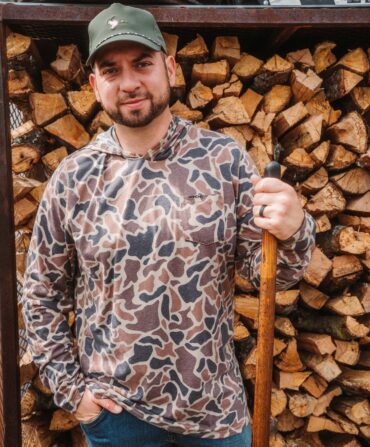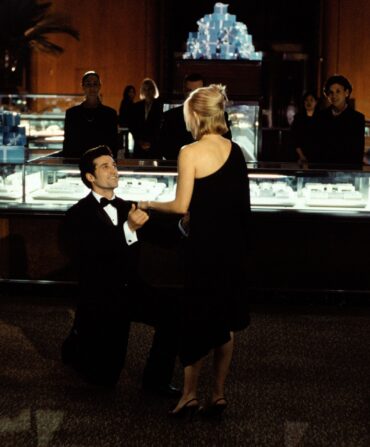This, I’m told, is this issue’s loose theme:
“Off the beaten path.”
Okay.

It’s not as though my mind is teeming with themes, and it’s always nice to fit in. So I free-associate:
“Off the…hmm. Beaten…path…hmm.”
And I come up with…
Oh no! Not that!
I come up with the chunk.
In my New Orleans courtyard, the chunk sits just inches downriver…
(That’s how we do directions in New Orleans: lakeside, riverside, upriver, downriver. Though there may be no water in sight, we have reason to know that the Mississippi and Pontchartrain are there, framing us more truly than points of the compass.)
…just inches downriver of our yesterday, today, and tomorrow bush.
Here is why that bush (scientific name Brunfelsia grandiflora) is called yesterday, today, and tomorrow. When its flowers open (let’s say yesterday), they are purple, then they fade (today) to lavender, and then (tomorrow) they’re white—and the progression is staggered so that all three colors are present at once.
It’s a beautiful plant.
There is nothing beautiful about the chunk.
But the chunk is thematic, as part of a path that was beaten.
I won’t say yet what this chunk was beaten by, but I’ll tell you what it was beaten off of.
A path.
The chunk is a roughly ten-by-fifteen-inch chunk of pavement, with a bit of broken white stripe on it.
I picked up that chunk not long ago from a pile of road rubble next to a hand-scrawled sign that says: ISLE DE JEAN CHARLES IS NOT DEAD—CLIMATE CHANGE SUCKS!
This chunk is part of what’s left of a road that has ended abruptly, because climate change has, in fact, despite what the sign says, undoubtedly washed away Isle de Jean Charles.
I snuck it in on you. I’m sorry. I don’t want to acknowledge climate change either. That ugly chunk reminds me that I ought to be doing something to save Mother Earth!
Which is such a drag.
You know of course that an honest map of Louisiana would no longer look like a boot. The ankle part is there, but so much of the foot part has been washed out into the Gulf, and is continuing to be washed out, that nothing but shreds are left. A man I know who worked on a high floor of a building in the Central Business District of New Orleans says, “You used to be able to look out and see a long way—seeing land and structures. Now you look out that way, to the south and east, and all you see is water and the sun coming up toward you.” Isle de Jean Charles, an island community of seven hundred souls, many of them Native Americans speaking their own version of Cajun French, is essentially gone.
The path toward what remains of Isle de Jean Charles has taken a beating from more than hurricanes and rising water levels. It has been deprived of former land-sustaining sediment by construction upriver and by wells and canals dug for oil and gas. And by invasive ugly-orange-toothed vegetation-ravaging beaverlike animals called nutria. And by my own personal neglect.
That chunk of mine, which used to be attached to what used to be part of lower Louisiana, is all of our planet I can say I have saved.
I do recycle and I do compost and I do try not to overcool or overheat our house, and I did eat nutria once (in support of a nutria-reduction campaign that failed because most people, even in Louisiana, are not open-minded about eating a rodent).
And I cling to any good news! In 1978 the U.S. Geological Survey concluded that Louisiana was losing a football field every thirty-four minutes. In 2016, thanks in part to restoration efforts, that rate had slowed to a football field every one hundred minutes.
Whew!
Of course, if you’re like me, you don’t want to lose one football field. Ever. You don’t even want to lose a game…
So easy to lose perspective. Such a heavy lift, to root for the earth.
A geologist who in 2009 warned of the Louisiana coastland’s demise says, now, “I’m not saying the river is sediment rich, but it just may not be as sediment starved as we commonly thought. And…some carefully planned diversions might actually be able to really create a return on investment.”
Land building! More dirt in than dirt out! Rah! Rah!
But I am of the past, which has brought us to here. We need a TikTok. Gridirons torn to shreds by orange teeth. Something less yesterday than my chunk.








